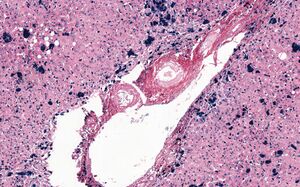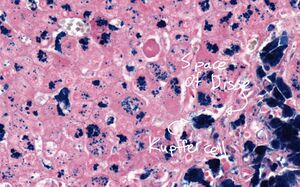10. Haemosiderosis of liver: Difference between revisions
(Created page with "'''Staining''': Prussian blue, HE '''Organ''': Liver '''Description''': With the Prussian blue stain, we can see normal liver tissue with small, medium and large accumulation of blue pigment. Notably, the pigment can be seen inside the epithelial cells of the bile duct in the portal triads. With the HE stain, the description is similar, however the pigment is brownish instead of bluish. '''Diagnosis''': Hemosiderosis in the liver '''Theory''': The pigment can not...") |
(No difference)
|
Revision as of 08:55, 9 May 2022
Staining: Prussian blue, HE
Organ: Liver
Description:
With the Prussian blue stain, we can see normal liver tissue with small, medium and large accumulation of blue pigment. Notably, the pigment can be seen inside the epithelial cells of the bile duct in the portal triads.
With the HE stain, the description is similar, however the pigment is brownish instead of bluish.
Diagnosis: Hemosiderosis in the liver
Theory:
The pigment can not only be found in the Kupffer cells (liver macrophages), but also in hepatocytes and even in the biliary epithelial cells in the bile ducts. Cases where hemosiderosis can be seen in these biliary cells are more severe than when the biliary cells don’t have the pigment.



